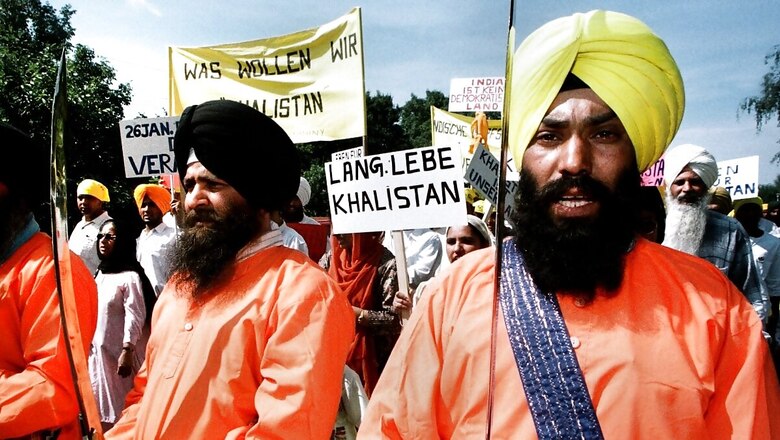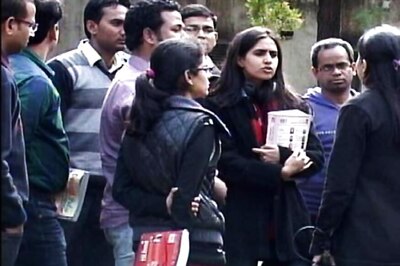
views
The story of the Sikh community is a historically stirring and important chapter within the studies of Indian history. It tells a tale of the rise of a group of people from among the followers of Guru Nanak, a Jat Hindu religious saint, who all ultimately turned into a community of warriors under severe Islamic persecution, and finally created a kingdom of their own under the famous warrior chief Maharaja Ranjit Singh. In the context of the current disturbances created in India and abroad by a group of people who term themselves the Khalistanis (from within the Sikh community), this article will take a brief look at the history of Sikhs, its similarities with Hinduism, and explore how the problem of Khalistan was created.
History of Sikhs
The Sikh sect was founded by Guru Nanak Dev (1469-1538 CE) and continued by nine other Gurus, the last of whom was Guru Govind Singh (1675- 1708 CE). Guru Nanak came from a Vaishnava family, living in the part of Punjab which is now in Pakistan, post-1947. He was born at a time when the Islamic invaders had already inflicted grave damage on Hindu morale through persistent and widespread temple destructions, forced conversions, and severe persecution. It was in such an atmosphere that Guru Nanak started his preaching, going back to the original philosophical teachings of Hinduism from the Vedas, Upanishads, and Dharmasastras.
Guru Nanak was actually part of a religious phenomenon that was sweeping India at that time, in response to Islamic aggression, in the form of what was later historically termed the Bhakti movement. As the Hindu kings and chiefs fought against Islamic invaders across the country, Hindu saints and philosophers started a spiritual revolution which came to be known as the Bhakti Movement. The movement, with its central theme based on the Puranas and various Dharmasastras, had few variations, wherein in some parts of India, the saints focused on the Advaita school of thought (mysticism) as found in the Upanishads and Yoga traditions. The Advaita school of thought was popular in the Northwestern parts of the Indian subcontinent, particularly so, because of the large-scale destruction of Hindu temples that these areas had witnessed and the various restrictions faced by the Hindus in their daily religious practices. It was the Advaita school of thought that Guru Nanak propounded as his spiritual teachings, and through his various idioms and verses. His followers were referred to as Sikhs, a term derived from the Sanskrit word sishyas, meaning devoted followers or disciples. The fourth Guru, Ram Das (1574-1581 CE), excavated a tank that was later named Amritsar, and soon a temple of Hari or Harimandir was built in the middle of this tank, which became the main seat of the Sikh sect, with the sanctum housing the Adi Granth that contains compositions of Sikh Gurus, Hindu saints, and few Sufis influenced by the Advaita philosophy.
The Adi Granth
Compilation of the Adi Granth was started by the fifth Guru, Arjan Dev (1581-1606 CE), and completed by the tenth Guru, Govind Singh. If one reads the Adi Granth closely, he or she will find that it is completely in sync with the philosophy and spirituality of the Vedas and Upanishads. As Ram Swarup says in his book: “There is nothing in Sikhism – its diction, its imagery, its idiom, its cosmogony, its mythology, its stories of saints and sages and heroes, its metaphysics, its ethics, its methods of meditation, its rituals – which is not derived from the scriptures of Hinduism. The ragas to which the hymns and songs of the Adi Granth were set by the Gurus are based on classical Hindu music. The parikrama (perambulation) performed by Sikhs round every Gurudwara, the dhoop (incense), deep (lamp), naivaidya (offerings) presented by the devotees inside every Sikh shrine, and the prasadam (sanctified food) distributed by Sikh priests resemble similar rites in every other Hindu place of worship. A dip in the tank attached to the Harimandir is regarded as holy by Hindus in general and Sikhs in particular as a dip in the Ganga or the Godavari.”
~ (“Hindu-Sikh Relationship,” 1985, p. 5).
Khuswant Singh also reiterates the same in his book “Why I Supported the Emergency,” 2015: “The roots of Sikhism lie deep in the Bhakti form of Hinduism. Guru Nanak picked what he felt were its salient features: belief in one God who is undefinable, unborn, immortal, omniscient, all-pervading and the epitome of Truth; belief in the institution of the Guru as the guide in matters spiritual; unity of mankind without distinction of caste; rejection of idol worship and meaningless ritual; sanctity of the sangat (congregation) which was expected to break bread together at the Guru ka Langar; the gentle way of sahaj to approach God while fulfilling domestic obligations; hymn singing (kirtan); emphasis on work as a moral obligation. The Adi (first) Granth is essentially a distillation of the Vedanta in Punjabi, the Dasam (tenth) is a compilation of tales of valour of Hindu goddesses, some composed by the Guru himself, others by bards of his court.”
There are many more such similarities between the Adi Granth and the different Hindu texts, as in the Isa Upanishad, there is a verse that says: “It is far; It is near; It is within all this: It is outside all this.” Guru Nanak says the same in the lines: “He is near; He himself is far; He himself is in the midst.” A verse from the Taittiriya Upanisads, “From fear of Him, the fire burns, from fear the Sun gives heat, from fear do Indra, Wind and Death spread along” is repeated in the Adi Granth (p. 464) as, “In fear the wind blows … in fear Dharma Raj (Death) … in fear the Sun, in fear the moon”. The hymn of creation in the Vedas (RV, 10.129) is there in Guru Nanak’s Shabads, where he says: “In the beginning, there was indescribable darkness. There was neither earth nor heaven … neither day nor night…”
A new breed of so-called scholars have claimed that Sikhism has very little or nothing to do with Hinduism; however in reality, of the 15020 times the name of God has appeared in the Adi Granth, Guru Nanak himself had used the word “Hari’ 630 times in it, while in total, ‘Hari’ occurs 8,300 times in the book; while ‘Rama’ appears 2,533 times, along with Prabhu, Gopal Govind, and other Hindu names for the divinity. The purely Sikh term ‘Wahe Guru’ appears only 16 times in the book (Khushwant Singh, “Why I Supported the Emergency,” 2015).
While some 19th-20th British created and later Marxist (post-independence) scholars have put forward theories that the monotheism in Sikhism is derived from Islam, nothing can be farther from the truth. In Vedic Hinduism, there is the concept of Brahman or Supreme Consciousness, the sole Being, and the Creator of all living things in this world, a clear form of monotheism. The Advaita school of thought, as found in the Upanishads, is derived from this concept of the Supreme Brahman, and it is this form of spirituality and philosophy that was adopted by Guru Nanak and the other Gurus of the Sikhs.
Sikhs and Islamic persecution
As the sayings of Guru Nanak gained popularity bringing back many of the converted, it alarmed the Muslim religious heads, and under their guidance, Jahangir (1605-1627 CE) tortured and executed the fifth Sikh Guru, Arjan Dev in 1606, for “spreading falsehood and tempting Muslims to apostasy.” Guru Arjan Dev was the first of the two Gurus martyred in the Sikh faith for refusing to change religion and accept Islam.
After the death of Guru Arjan dev, the sixth Guru, Har Govind (1606-1644 CE), decided to introduce martial combat arts in the Sikh community as a self-defence mechanism, and he formed a small army that would resist the Muslim persecution. However, Aurangzeb (1658-1707 CE), summoned the ninth Sikh Guru, Tegh Bahadur (1664-1675 A.D.) to Delhi and had him executed when he refused to accept Islam in 1675. Along with Guru Tegh Bahadur, some of his followers who had accompanied him were also tortured and killed. After this, the 10th and final Guru of the Sikhs, Govind Singh, decided that a change in Sikhism was necessary to fight Islamic oppression; a process already initiated by Guru Har Govind and completed by Govind Singh when he created the Khalsa Panth in 1699 CE.
Guru Govind Singh, a great scholar, was a believer in Devi Durga-Mahisasuramardini. He performed a hom-yajna and invoked the Devi for her blessings in his fight to protect dharma, and the Devi’s answer came in the form of a sword, which became a symbol of his war against religious oppression. Once initiated, the Khalsa members were asked to wear five emblems symbolising this order: Kesh (long hair), Kangha (comb), Kada (steel bracelet), Kachha (shorts), and Kirpan (sword); and the honorary title of Singh (lion) was added to their names so that they could be distinguished from the non-Khalsa Sikhs. The Khalsa Panth was a martial body within the larger Sikh community, to fight against Muslim tyranny. Soon, it became a much-revered tradition in many Hindu and Sikh families to dedicate their eldest sons to the Khalsa Panth, which was regarded as the martial arm of the Hindu-Sikh society.
The issue of Khalistan
The British, in their divide-and-rule policy, sowed the seeds for the Khalistan movement by dividing Punjabi society into Hindu and Sikh, which they started in the 1860s, soon after the 1857 mutiny. The British needed the Sikhs in their army to fight against the various Hindu kingdoms, and to keep the two separate, they slowly started planting the idea of a separate nation for the Sikhs. This was started by attempts at separating the Sikh community from the parent Hindu body by turning Sikhism into a different religious minority group (akin to the Muslims and Christians). This was achieved to some extent by using well-tutored and well-funded Sikh scholars and religious heads who started the narrative of Sikhism being completely different from Hinduism, with greater closeness to Islam and Christianity (monotheism).
Besides using academicians and religious heads, the British also played at political levels, and started Singh Sabhas, functioning under Khalsa Diwans (in Lahore and Amritsar), which owed complete loyalty to the British (the British-created Sikh loyalists had no connection with the Khalsa Panth created by Guru Govind Singh, a martial group to fight Islamic oppression).
In 1872, these Sikhs, loyal to the British, supported the cruel crackdown on the Namdhari Sikhs (for Swadeshi movement), and also favoured the 1914 brutal crushing of the Ghadarites (NRIs – immigrant Indians residing in America). This was followed by removal of the Brahmin priests from Har Mandir, and throwing out Hindu deities from this temple. That there were Hindu deities installed inside Har Mandir is clear from a letter written by a student, Bir Singh (in 1897), which speaks of a painting of Devi Durga on the front wall of a room near the Dukhbhanjani Beri in the Golden Temple. As the student described, the multi-armed Devi stood on golden sandals and in one of her outstretched hands, she held a khanda, while Guru Govind Singh stood barefoot in front of the Devi with his hands folded.
Post-independence, the seeds of divisiveness sown by the British began to bear fruit, and what started as a game to keep the Hindus and Sikhs divided for political control, snowballed into a full-scale terror movement known as the Khalistani separatist movement, aided by Pakistan, which peaked in the late 1970s-1980s.
The current Khalistani unrest, aided by Pakistan, is again a desperate attempt at creating an atmosphere of violence and chaos in India. The Central government will have to tackle this menace in a careful manner, and will have to suppress the terrorists with an iron hand, without making the mistake of putting the Sikhs and Hindus at loggerheads with each other.
The author is a well-known travel and heritage writer. Views expressed are personal.
Read all the Latest Opinions here




















Comments
0 comment